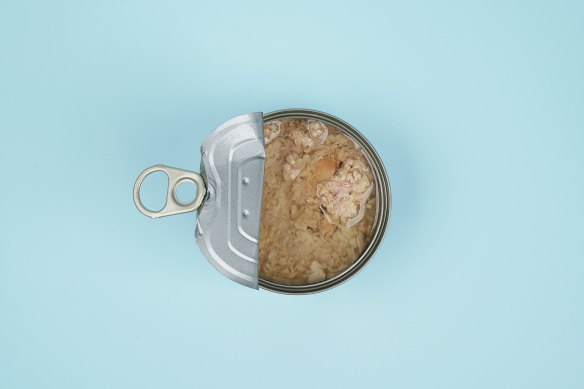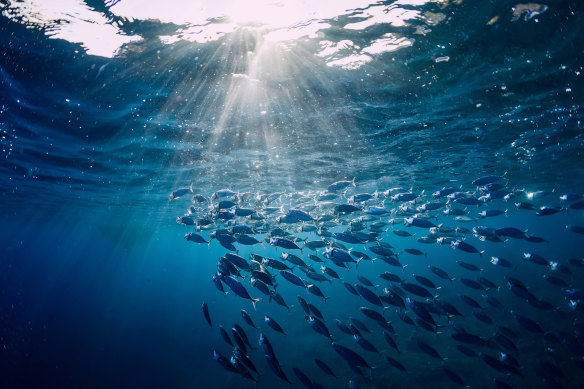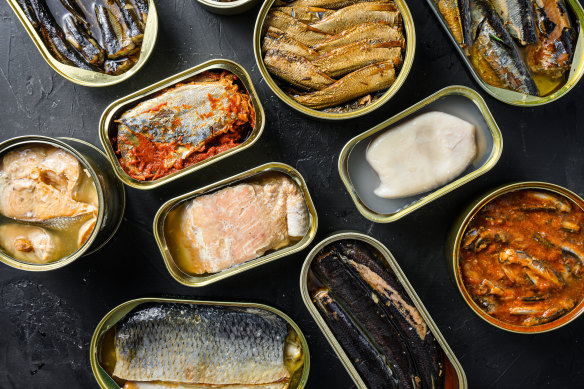This was published 6 months ago
How worried should we really be about mercury in canned tuna?
In Australia, we like our tuna. According to the Marine Stewardship Council, 14.4 million Australians buy canned tuna each year, with Millennials and parents topping the list. And while we are not at the scale of Japan, the European Union and US, tuna remains a big part of our seafood consumption, along with other large oceanic fish such as shark, salmon and prawns.
Fish consumption is linked to many health benefits and the prevention of various conditions including obesity, metabolic syndrome and cardiovascular diseases. Oily fish, such as tuna and salmon, are particularly high in essential omega-3 fatty acids and a good source of protein, with health authorities recommending them as a regular part of everyone’s diet.

According to the Marine Stewardship Council, 14.4 million Australians buy canned tuna each year. Credit: Getty Images
But there are caveats. In the case of tuna and other piscivorous fish (who eat other fish), it’s the threat of mercury poisoning. But how worried should we be?
What is mercury, and how does it end up in fish?
Mercury is a metallic element that is released into the air either naturally – through volcanic eruptions or emissions from the ocean – or through emissions caused by humans, through the release of fossil fuels or industrial processes.
It is these anthropogenic mercury emissions that pose the greatest danger to humans, says Australian National University Associate Professor and environmental scientist Larissa Schneider. They have been rising steadily since the dawn of the industrial age and the introduction of mining.
When rocks and minerals are mined, the activity releases an “inorganic” form of mercury into the atmosphere and waterways, Schneider says.
The problem is that once that mercury enters the aquatic environment, micro-organisms can alter it to a much more toxic “organic” form, which can be absorbed through the digestive tract and spread throughout the body, including to the brain.
“As larger predators like tuna eat these smaller fish, the mercury accumulates in their bodies because it does not break down or leave the body easily. For each step up the food chain, the concentration of mercury gets higher, especially in top predators,” Schneider says.

Once mercury released by human activity enters the aquatic environment, micro-organisms can alter it to an ‘organic’ form, which can be absorbed through the digestive tract and spread throughout the body.Credit: Getty Images
The size and age of fish matter too. The bigger and older the fish, the higher the likelihood of it eating a lot of smaller fish over a longer period of time, meaning prolonged and larger exposure to mercury, which can then be passed on to humans.
“Tuna are high up the food chain. Because of their lifestyle and rapid metabolism, they consume a lot of fish to supply their energy needs and are, therefore, exposed to high amounts of mercury in their diet,” says environmental chemist Edward Butler.
How much fish should we eat?
There are two types of mercury exposure: acute and chronic. Dr Ian Musgrave, a molecular pharmacologist from the University of Adelaide, says unless you work in industries that deal with mercury, most people will only face exposure to low environmental levels of the metal.
“Because mercury – especially methyl mercury – bioaccumulates, the major concern is over long-term environmental exposure, where concentrations could build up in people. The effects may be subtle but insidious,” he says.
While the human body gets rid of mercury over time, voracious seafood eaters should still keep an eye on the amount of fish they consume. Our bodies are good at selectively gathering any mercury we ingest and trapping it in our bodies. Usually, that’s not a problem, unless it gets into the brain.
“The brain is a major target of mercury toxicity, and can be associated with tremors, anxiety, depression, irritability, memory problems and numbness of the hands, feet, or mouth,” says Musgrave.
Are some people more vulnerable?
Yes, pregnant people and children. Because mercury can freely cross the placenta and accumulate in the fetal brain, it can impact a baby’s neurological development. However, once the baby is born, the danger is over, as the levels of mercury in breast milk are not high enough to be a risk.
But before you panic, experts stress that mercury poisoning is very rare.

CSIRO scientists found that a person would have to eat around 25 tins of tuna a week before hitting the maximum tolerable intake of mercury.Credit: Getty Images
“A one-off consumption of a piece of flake and a tin of tuna in the same week will not precipitate mercury poisoning,” says Musgrave, pointing to the Food Standards Australia New Zealand’s guidelines around safe limits for mercury consumption from all fish, not just tuna.
The guidelines, which define a portion as 75g for children under six and 150g for everyone else, recommend that pregnant and breastfeeding women consume no more than one portion per week of orange roughy (deep sea perch) or catfish and no other fish that week, or one portion per fortnight of shark (flake) or billfish (swordfish/broadbill and marlin) and no other fish that fortnight.
“Flake is relatively high in mercury and Australian women of childbearing age should eat flake no more than once a fortnight, with no other fish. For the rest of the population, flake once a week with no other fish is recommended,” Musgrave explains.
A 2022 lab experiment by CSIRO scientists found that a person would have to eat around 25 tins (at 95g a tin) of tuna a week before hitting the maximum tolerable intake of mercury. For pregnant women, that limit would be around12 tins per week
Is Australian tuna safer?
Generally speaking, yes. However, Australia has several estuaries that have faced contamination from industrial discharge, urban runoff and historical mining activities. For instance, mercury concentrations are notably high in fish from the Derwent Estuary and Port Phillip Bay.
In general, the Southern Hemisphere is a “cleaner” environment for mercury, as it contains more water, less landmass and less industry than its northern counterpart, meaning less pollution, Schneider says.
In Australia, the main tuna species sold in supermarkets include skipjack and yellowfin, with skipjack being the smaller of the two species. The fact that these are smaller species is already a good thing, as they bioaccumulate less mercury.
Make the most of your health, relationships, fitness and nutrition with our Live Well newsletter. Get it in your inbox every Monday.